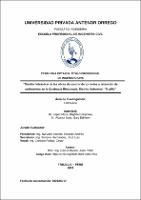| dc.contributor.advisor | García Rivera, Juan Pablo | |
| dc.contributor.author | López Maza, Brighite Estephany | |
| dc.contributor.author | Álvarez Borja, Gary Edinson | |
| dc.creator | López Maza, Brighite Estephany | |
| dc.date.accessioned | 2021-08-06T19:14:50Z | |
| dc.date.available | 2021-08-06T19:14:50Z | |
| dc.date.issued | 2021 | |
| dc.identifier.uri | https://hdl.handle.net/20.500.12759/7842 | |
| dc.description.abstract | El Fenómeno del Niño en el mes de marzo del 2017, causo precipitaciones
intensas generadas por lluvias torrenciales, las cuales dieron origen a un
evento de máxima avenida que transporta lodo y escombros por las
quebradas, las cuales terminan desembocando en su cono de deyección,
lo que ocasiona problemas de inundación, erosión y acumulación de
sedimentos que representa un peligro constante para el canal madre,
siendo esta la principal Infraestructura Hidráulica con la que se abastece
las áreas agrícolas del Valle Moche y la Planta de Tratamiento de Agua
Potable.
La presente tesis consiste en el Diseño Hidráulico de las Obras para el
control de torrentes y retención de sedimentos en la Quebrada Rinconada,
para ello previamente se realizó el modelamiento hidrológico e hidráulico.
Para el modelo Hidrológico, se realizó la caracterización de la Quebrada
Rinconada, la cual se dividió en 3 ramales, de las cuales se obtuvo sus
parámetros principales, y también los datos históricos de precipitación de
las diferentes Estaciones. Por consiguiente, el modelo hidrológico se realizó
con los softwares ArcGIS y HEC-HMS. De esta manera se pudo determinar
los caudales máximos de los periodos de retorno de 50, 100, 140 y 200
años.
Para el modelo hidráulico se utilizó el software FLO-2D, el cual tuvo como
parámetros de entrada al hidrograma calculado por el modelo hidrológico,
la topografía digital del terreno, y los parámetros reológicos como la
viscosidad y el esfuerzo de cedencia, para luego obtener como resultados,
las velocidades y profundidades máximas de los periodos de retorno
determinados con anterioridad.
El diseño Hidráulico se realizó para los caudales máximos,
correspondientes a un periodo de retorno de 140 años.
Finalmente, se integró las estructuras propuestas al modelamiento, el cual
ha dado resultados satisfactorios para estabilizar las quebradas, reducir los
efectos de los huaycos y así proteger el canal madre | es_PE |
| dc.description.abstract | The phenomenon of child in the month of March 2017, caused intense
rainfall generated by torrential rains, which gave rise to a maximum avenue
event that transports mud and debris through the streams, which end up
flowing into their dejection cone, which that causes problems of flooding,
erosion and accumulation of sediments that represent a constant danger for
the mother canal, this being the main Hydraulic Infrastructure with which the
agricultural areas of the Moche Valley and the Drinking Water Treatment
Plant are supplied.
This thesis consists of the Hydraulic Design of the Works for the control of
torrents and sediment retention in the Rinconada Stream, for which the
hydrological and hydraulic modeling was previously carried out.
For the Hydrological model, the characterization of the Rinconada Creek
was carried out, which was divided into 3 branches, from which its main
parameters were obtained, as well as the historical precipitation data of the
different Stations. Therefore, the hydrological model was carried out with
the ArcGIS and HEC-HMS software. In this way it was possible to determine
the maximum flows of the return periods of 50, 100, 140 and 200 years.
For the hydraulic model, the FLO-2D software was used, which had as input
parameters the hydrograph calculated by the hydrological model, the digital
topography of the terrain, and the rheological parameters such as viscosity
and yield stress, to later obtain as results, the maximum speeds and depths
of the return periods determined in advance.
The Hydraulic design was carried out for the maximum flows, corresponding
to a return period of 140 years.
Finally, the proposed structures were integrated into the modeling, which
has given satisfactory results to stabilize the streams, reduce the effects of
the huaycos and thus protect the mother canal | en_US |
| dc.description.uri | Tesis | es_PE |
| dc.format | application/pdf | es_PE |
| dc.language.iso | spa | es_PE |
| dc.publisher | Universidad Privada Antenor Orrego | es_PE |
| dc.relation.ispartofseries | T_CIVIL_1970 | |
| dc.rights | info:eu-repo/semantics/openAccess | es_PE |
| dc.rights.uri | https://creativecommons.org/licenses/by/4.0/ | es_PE |
| dc.source | Universidad Privada Antenor Orrego | es_PE |
| dc.source | Repositorio Institucional - UPAO | es_PE |
| dc.subject | Hidráulico | es_PE |
| dc.subject | Sedimentos | es_PE |
| dc.title | Diseño hidráulico de las obras de control de torrentes y retención de sedimentos en la Quebrada Rinconada, Distrito Salaverry - Trujillo | es_PE |
| dc.type | info:eu-repo/semantics/bachelorThesis | es_PE |
| thesis.degree.level | Título Profesional | es_PE |
| thesis.degree.grantor | Universidad Privada Antenor Orrego. Facultad de Ingeniería | es_PE |
| thesis.degree.name | Ingeniero Civil | es_PE |
| thesis.degree.discipline | Ingeniería Civil | es_PE |
| dc.subject.ocde | https://purl.org/pe-repo/ocde/ford#2.01.00 | es_PE |
| renati.advisor.orcid | https://orcid.org/0000-0003-3498-7934 | es_PE |
| renati.author.dni | 47534208 | |
| renati.author.dni | 45146463 | |
| renati.advisor.dni | 18216844 | |
| renati.type | https://purl.org/pe-repo/renati/type#tesis | es_PE |
| renati.level | https://purl.org/pe-repo/renati/level#tituloProfesional | es_PE |
| renati.discipline | 732016 | es_PE |
| renati.juror | Narváez Aranda, Ricardo Andrés | |
| renati.juror | Serrano Hernández, José Luis | |
| renati.juror | Cancino Rodas, Cesar | |
| dc.publisher.country | PE | es_PE |


